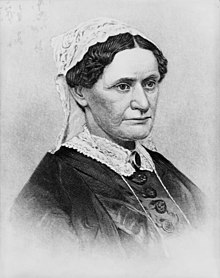Our website is made possible by displaying online advertisements to our visitors.
Please consider supporting us by disabling your ad blocker.
Eliza McCardle Johnson
Eliza McCardle Johnson | |
|---|---|
 Official portrait, as engraved 1883 | |
| First Lady of the United States | |
| In role April 15, 1865 – March 4, 1869 | |
| President | Andrew Johnson |
| Preceded by | Mary Todd Lincoln |
| Succeeded by | Julia Grant |
| Second Lady of the United States | |
| In role March 4, 1865 – April 15, 1865 | |
| Vice President | Andrew Johnson |
| Preceded by | Ellen Hamlin |
| Succeeded by | Ellen Colfax |
| First Lady of Tennessee | |
| In role October 17, 1853 – November 3, 1857 | |
| Governor | Andrew Johnson |
| Preceded by | Frances Owen |
| Succeeded by | Martha Mariah Travis |
| In role March 12, 1862 – March 4, 1865 | |
| Governor | Andrew Johnson |
| Preceded by | Martha Mariah Travis |
| Succeeded by | Eliza O'Brien |
| Personal details | |
| Born | Eliza McCardle October 4, 1810 Greeneville, Tennessee, U.S. |
| Died | January 15, 1876 (aged 65) Greeneville, Tennessee, U.S. |
| Resting place | Andrew Johnson National Cemetery Greeneville, Tennessee |
| Spouse | |
| Children | |
| Signature |  |
| ||
|---|---|---|
|
Personal 16th Vice President of the United States 17th President of the United States Vice presidential and Presidential campaigns Post-presidency Family  |
||
Eliza McCardle Johnson (née McCardle; October 4, 1810 – January 15, 1876) was the first lady of the United States from 1865 to 1869 as the wife of President Andrew Johnson. She also served as the second lady of the United States March 1865 until April 1865 when her husband was vice president. Johnson was relatively inactive as first lady, and she stayed out of public attention for the duration of her husband's presidency. She was the youngest first lady to wed, doing so at the age of 16.
Johnson significantly contributed to her husband's early career, providing him with an education and encouraging him to strengthen his oratory skills and seek office. Johnson did not participate in the social aspects of politics, however, remaining at home while her husband took office. During the American Civil War, she was forced from her home for her family's Unionist loyalties. She was affected by tuberculosis throughout much of her life, and what activity she did choose to undertake was limited due to her health.
Johnson was briefly the second lady of the United States before becoming the first lady, as her husband was vice president until the assassination of Abraham Lincoln. After becoming the first lady, Johnson delegated the role's social duties to her daughter Martha Johnson Patterson. Though she only made two public appearances during her tenure as first lady, Johnson was a strong influence on her husband, and he would consult her regularly for advice. Johnson returned to her home of Greeneville, Tennessee with her family after leaving the White House, living a quiet retirement. She died six months after her husband and was buried beside him.
Previous Page Next Page



